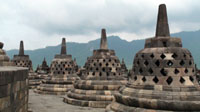
INDONESIA has launched an initiative to bring back the tourism in the country in the aftermath of the two hotel bombings in Jakarta. The two hotels, the Ritz-Carlton and Marriott, have long since resumed normal operations and the industry is looking to make up lost ground in a year which had seen an increase in international tourism arrivals.
Tourism Minister Jero Wacik announced that the government will be injecting $9.3 million into the ministry’s tourism recovery programme, and that all major hotels had also tightened up security measures for visitors, including stricter control at airports.
One tourist attraction in the country that has not seen any economic downturn is Borobudur – the world’s largest and many would argue most beautiful Buddhist temple, which is decorated with 2,672 relief panels and 504 Buddha statues. It lies in Yogyakarta – Indonesia’s third largest city, whose fortunes are largely dependent on tourism.
Borobudur, constructed on a hill and consisting of eight layers, is the single most visited tourist attraction in Indonesia. In 1974, 260,000 tourists - of whom 36,000 were foreigners - visited the monument. Within 20 years, this figure rose to 2.5 million visitors annually (of whom 80 per cent were domestic tourists).
In the first four months of 2009, visitor numbers were up by 10 per cent on the previous year to 614,000, with January showing a 30 per cent hike in visitors. Foreign visitors make up only six per cent of that mix albeit that their numbers have been increasing at the same rate, although it is too early to ascertain what effect the recent bombings in Jakarta will have on these figures.
Similar numbers are recorded at the Prambanan Hindu temples compound which is the biggest temple complex in Java. There are 224 temples altogether, with three on the central terrace at up to 47 metres high dominating the complex. Following the May 2006 earthquake, however, many parts of Prambanan are roped off to visitors until they are eventually made safe.
While visitor numbers are increasing, what is noticeable is their change of origin. Yogyakarta’s Hyatt Regency hotel caters predominantly for Japanese tourists, and bookings from Japan have fallen sharply, perhaps by as much as 30 per cent. The more downmarket ibis, however, which caters mainly for domestic visitors, is almost permanently full; and the Amanjiwo – one of the five top end luxury boutique Aman resorts in the country, where rates start at $700 per night rising to $2,600 for its top suite – continues to attract visitors from all corners of the globe, especially the Middle East.
Amanjiwo is almost a destination in its own right, lying within a natural amphitheatre at the foot of the Menoreh Hills overlooking Borobudur.
By any measure, Yogyakarta must surely rank as one of the most beautiful tourist destinations in the country – a veritable jewel in the crown of Indonesia.
By Brian Salter
